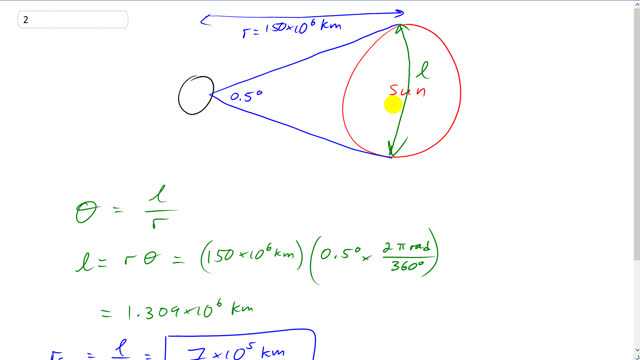
The Sun subtends an angle of about to us on Earth, 150 million km away. Estimate the radius of the Sun.

In order to watch this solution you need to have a subscription.
This is Giancoli Answers with Mr. Dychko. When this question says that the Sun subtends an angle of 0.5 degrees; the word 'subtends' is a fancy way of saying that the Sun is opposite this angle of 0.5 degrees. So if you are a single observer on the Earth here and you were to measure the angle between your line of sight to one side of the Sun to your line of sight to the other side of the Sun, you would have an angle of 0.5 degrees between these two line's of sight. Now with the Sun being so far away, we are gonna assume that this arc length along this little bit of the circle is gonna be the same as the diameter of the Sun and we'll find the radius of the Sun then by dividing this arc length by 2 and that's gonna be a pretty good assumption with the Sun being so far away— 150 million kilometers away. And the other assumption we are making is that we are so far away that our line of sight is tangent to the Sun at this point at the very top of the Sun and likewise the very bottom of the Sun whereas you know, if we happen to be an observer that was... say here is the Earth then our light of sight would be, you know, here and then the other line of sight would be touching this point on the Sun and then well clearly this arc length is now representative of the diameter to the Sun because we are just in this portion here rather than through the center. Anyhow, these are all just little details but... and I mean the way to answer this question is really straightforward so I thought I'd throw a little bit of more stuff in there so that this question teaches you more than just how to use this formula here. So we are so far away that we can make this assumption that the diameter of the Sun is the arc length of a circle between this point and this point. Okie-doke! So radians are defined as the arc length divided by the radius of the circle and the radius of the circle we are concerned with is this circle that we imagined from where we are positioned on the Earth to the center of the Sun—this radius here— so it's the Earth-Sun distance, in other words. And l is this arc length here and we can solve for l by multiplying both sides by r and we get l is r times the angle when it's expressed in radians. So we have 150 times 10 to the 6 kilometers times 0.5 degrees converted into radians by multiplying by 2π radians for every 360 degrees and we end up with 1.309 times 10 to the 6 kilometers and this answer is in kilometers because we used kilometers in our calculations. And we did not need to convert it into meters— although we could have and that would be fine— we didn't need to because there are no other units anywhere in this formula so there wasn't gonna be any conflict between units; no need to do mks—meters, kilograms, seconds—here because this units of radians are really dimensionless. Okay! So radius of the Sun then is this arc length from here to here divided by 2 and that's gonna be 7 times 10 to the 5 kilometers.
Why did you divide by 2?